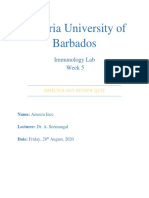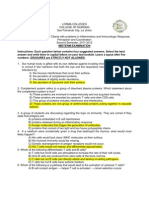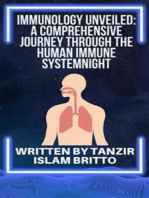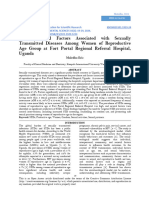Chapter 1 - Answers
Chapter 1 - Answers
Uploaded by
throwawyCopyright:
Available Formats
Chapter 1 - Answers
Chapter 1 - Answers
Uploaded by
throwawyOriginal Title
Copyright
Available Formats
Share this document
Did you find this document useful?
Is this content inappropriate?
Copyright:
Available Formats
Chapter 1 - Answers
Chapter 1 - Answers
Uploaded by
throwawyCopyright:
Available Formats
CHAPTER 1 Multiple Choice Choose the one alternative that best completes the statement or answers the question.
1. The most primitive component of the immune response found even in some of the simplest forms of life is the ability to A. distinguish self from non-self. B. produce phagocytes. C. produce antibodies. D. mount a cellular immune response. 2. Immunology was originally a subdiscipline of A. microbiology. B. blood banking. C. transplantation. D. anatomic pathology. 3. Which of the following is (are) characteristics of nonspecific, innate immunity? A. Responds to all challenges equally. B. Reacts without prior exposure to the agent. C. Has no memory. It does not react differently when reexposed to the same agent. D. Only needs to recognize agent as non-self to react. E. All of the above. 4. A child has chicken pox and recovers. Later, she is exposed to chicken pox and does not get sick, but when she is exposed to influenza she does get sick. This is an example of A. nonspecific immunity. B. innate immunity. C. adaptive immunity. D. vaccination. 5. A man opens up an old loaf of bread and inhales Penicillium spores from the organism growing inside. Inside the mans lungs, phagocytes engulf and digest the spores. The man never gets sick. This is an example of A. adaptive immunity. B. specific immunity. C. vaccination. D. variolation. E. innate immunity. 6. The definition of antigen is A. the portion of the antibody that binds to the microorganism. B. an infectious, pathogenic microorganism. C. the exact portion of a microorganism or chemical that the immune system reacts against. D. the portion of the white blood cell responsible for recognizing something as non self. 7. In the recognition phase of the immune response, the body must determine that A. a microorganism is capable of causing actual disease. B. a microorganism is different that what is usually present in the normal flora. C. a substance is capable of causing harm. D. the antigen encountered is non-self. 8. The first description of inflammation came from ancient Rome and included all the components listed below except A. redness. B. pus. C. swelling. D. heat. E. pain.
9. In humans, after the recognition phase of the immune reaction, the response phase consists of A. activation of the innate, nonspecific immune components. B. activation of the adaptive, specific immune components. C. Both A and B. D. Cannot tell from this information. It depends on the immunizing agent as to whether A or B is used. 10. The English physician who vaccinated a boy with cowpox to induce immunity to smallpox was A. Louis Pasteur. B. Celsus Galen. C. Edward Jenner. D. Peter Medawar. E. Robert Koch. 11. Simian immunodeficiency virus (SIV) causes a disease in monkeys similar to AIDS in humans caused by human immunodeficiency virus (HIV). In theory, why would SIV be a candidate organism to be used in a human AIDS vaccine? A. SIV could stimulate a cellular immune reaction against HIV. B. SIV could stimulate a humoral immune response against HIV. C. SIV could stimulate an immune response against SIV that cross-reacts with HIV. D. Monkey viruses cause disease in humans. E. Monkey viruses cannot cause disease in humans. 12. The person who won the Nobel prize in 1908 for his work in demonstrating phagocytosis by white blood cells is A. Elie Metchnikoff. B. Louis Pasteur. C. Robert Koch. D. Edward Jenner. E. Paul Erlich. 13. The first true vaccine given to a human containing the specific pathogen to which immunity was desired was A. chicken fowl cholera. B. anthrax. C. rabies. D. diphtheria. E. tetanus. 14. The first research identifying the activity of antibodies demonstrated that A. the immunity could be transferred from one animal to another using the serum component of blood. B. the immunity could be transferred from one animal to another using the cellular component of blood. C. the immunity was produced by B lymphocytes. D. the immunity was produced by T lymphocytes. 15. Hyperacute rejection of a solid organ transplant occurs if there is a mismatch of A. tissue types. B. ABO blood types. C. MHC types. D. HLA types. 16. The first successful human kidney transplant was in 1954. Why was it successful? A. The recipient and the donor were identical twins. B. The recipient and the donor had identical ABO blood groups. C. The recipient and the donor had identical tissue types. D. All of the above. 17. How were the cells responsible for cell-mediated immunity first identified as T lymphocytes? A. Metchnikoff demonstrated phagocytosis of fungal spores by Daphnia blood cells. B. Glick demonstrated it using cells isolated from chicken thymus. C. Ehrlich demonstrated it using cells isolated from the Bursa of Fabricius in chickens.
D. Landsteiner demonstrated it showing incompatibility between sera of people with different blood groups. 18. In early studies of antibodies, which properties were recognized? A. Ability to agglutinate particles B. Ability to cause precipitation reactions C. Antitoxin effects D. All of the above 19. The selective/clonal selection theory of immune response ultimately proved to be correct, but the instructional theory, while incorrect, seemed logical because A. it seemed reasonable that a cell would be instructed to react to a specific antigen only when it was encountered. B. the immune system was shown to be capable of such a wide variety of substances that it seemed impossible that such a high number of different possibilities would be preformed without any prior exposure. C. if thousands of preformed antibodies were present to antigens that are never encountered, this is excessively wasteful and poor use of the bodys resources. D. if one gene produces one antibody, then it didnt seem that humans had enough DNA to produce thousands of possible antibodies. E. All of the above. 20. Which breakthrough below is mostly responsible for supporting the clonal selection theory of the immune response? A. Discovery of how monocloncal antibodies can be produced artificially B. Discovery of the chain structure of antibodies C. Discovery of the T cell receptor D. Discovery of the genes encoding for different portions of antibody molecule 21. What is a monoclonal antibody? A. An antibody produced by an immature B cell. B. An antibody produced by a mature, stimulated B cell. C. An antibody produced by a hybridoma cell. D. An antibody produced in response to an antigen with only one epitope. E. An antibody produced in response to an antigen with a repeating epitope. 22. How can hybridoma cells be kept alive for extended periods of time? (Choose as many as apply.) A. They cant. Once removed from the host animal the cells die quickly. B. Using the appropriate cell culture techniques. C. Placing them into a susceptible host where they will form a tumor. D. Growing them in a field of ionizing radiation. E. Growing them at refrigerator temperature. 23. Which of the cell types listed below needs to have antigen processed before it can be recognized? A. T lymphocytes B. B lymphocytes C. Neutrophils D. Monocytes/macrophages E. Eosinophils 24. Which of the following is true regarding immunoglobulins? A. Immunoglobulins are also called antibodies. B. Immunoglobulins exist preformed on the surface of B lymphocytes. C. They are the major mediator of specific humoral immunity. D. All of the above. 25. T lymphocytes recognized foreign antigen and discriminate self from non-self using A. the T cell antigen receptor. B. the MHC complex. C. ABO antigens. D. A and B. E. A and C.
Short Answer Write the word or phrase that best completes each statement or answers the question. 26. T and B LC______________ are responsible for cell-mediated immunity while __Ab____________ are responsible for humoral immunity. 27. The study of organ transplantation was vastly improved when the cause of different tissue types , the __MHC____________, was discovered by Snell, Dausett, and Benacerraf. 28. The person who discovered the ABO human blood groups is _K. Landstainer_____________. 29. Rejection of transplanted organs can be minimized if _HLA__testing is done to assess tissue compatibility between donors and recipients. 30. __autoimmunity_____ is when ones own tissues are attacked by ones own immune system. True/False Write T if the statement is true and F if the statement is false. 31. F________ The human immune system never responds against human tissues. 32. T________ The adaptive arm of the immune system is capable of memory. 33. F________ In terms of organism survival, cellular immunity is more important than humoral immunity. 34. F________ Antibodies can only be formed against microorganisms or products they produce, such as toxins. 35. _F_______ When serum is divided into fractions by an electrical field, antibodies migrate in the beta fraction. 36. _T_______ It is believed that the phagocytic cells observed by Metchnikoff were macrophages and polymorphonuclear neutrophils. 37. T________ Louis Pasteur accidentally discovered vaccination using attenuated microorganisms by injecting an old bacterial culture into chickens. 38. _T_______ Paul Erlich was the first to propose that white blood cells had some structure that could bind to antigens similar to a lock and key. 39. T________ B lymphocytes can react against unprocessed antigen. 40. _T_______ T cells recognize antigens by virtue their corresponding receptors on their cell surfaces. Short Answer Write the word or phrase that best completes each statement or answers the question. 41. What was variolation? 42. Explain why Jenner was successful in making a boy immune from smallpox by vaccinating him with cowpox. 43. Define attenuation and explain why attenuated organisms are useful for vaccines. 44. Briefly outline the clonal selection theory of adaptive immunity. 45. Explain what a hybridoma cell is and what it does.
You might also like
- Kuby Immunology 7e TBDocument134 pagesKuby Immunology 7e TBStarrx71494% (18)
- ImmunoSerology - Review Questions (Stevens)Document14 pagesImmunoSerology - Review Questions (Stevens)LUALHATI VILLAS50% (2)
- Abbas Basic Immunology 3eDocument7 pagesAbbas Basic Immunology 3evudka100% (1)
- Immunology MCQ DrNaeem PDFDocument163 pagesImmunology MCQ DrNaeem PDFA-Naeem To'mah Al-sawaieNo ratings yet
- Immunology Practice QuestionsDocument52 pagesImmunology Practice QuestionsBigBoostingNo ratings yet
- Summary & Study Guide - The Beautiful Cure: Harnessing Your Body’s Natural DefensesFrom EverandSummary & Study Guide - The Beautiful Cure: Harnessing Your Body’s Natural DefensesNo ratings yet
- Andrew Hopkins Making Safety WorkDocument223 pagesAndrew Hopkins Making Safety Workkusumawardati100% (1)
- Lipid Metabolism MCQs (Cholesterol, Triglycerides, and Other Lipids) - 1639455481990Document8 pagesLipid Metabolism MCQs (Cholesterol, Triglycerides, and Other Lipids) - 1639455481990Lola Muhoza100% (2)
- Heal YourselfDocument198 pagesHeal Yourselfkeithmac100% (5)
- Software Requirements Engineering of Potato Plant DiseaseDocument24 pagesSoftware Requirements Engineering of Potato Plant DiseaseRizwan TahirNo ratings yet
- Immunology TBDocument9 pagesImmunology TBkaleb16_2No ratings yet
- Immunology Worksheet1Document4 pagesImmunology Worksheet1Caviles, Jasmin S.No ratings yet
- Chapter 07Document67 pagesChapter 07aljh62002No ratings yet
- Immunology-1st Master Q&ADocument20 pagesImmunology-1st Master Q&AIslam Fathy El Nakeep100% (1)
- Immunology Mscbi-1 Preuniversity Examination: Part ADocument15 pagesImmunology Mscbi-1 Preuniversity Examination: Part ADipankar Rot100% (1)
- Abbas Basic Immunology 3eDocument7 pagesAbbas Basic Immunology 3ePatricia Snowden100% (1)
- 2021 Trial Paper Mock 61714cbe0bad8Document26 pages2021 Trial Paper Mock 61714cbe0bad8Sia GuptaNo ratings yet
- Stevens IsDocument33 pagesStevens IsButter CreamNo ratings yet
- اهم اسئلة 2Document32 pagesاهم اسئلة 2Adam JerusalemNo ratings yet
- Immune BankDocument22 pagesImmune BankFaris MohamedNo ratings yet
- Immunology-1st Master QDocument20 pagesImmunology-1st Master QIslam Fathy El NakeepNo ratings yet
- Is - StevensDocument49 pagesIs - StevensALEXANDRA CALANOCNo ratings yet
- Immune System (Non-Specific & Specific Defences) - ANSWERDocument23 pagesImmune System (Non-Specific & Specific Defences) - ANSWERincognitus94No ratings yet
- Week 10 Learning ActivityDocument4 pagesWeek 10 Learning ActivityTatiana GreenNo ratings yet
- Coursebook Answers Chapter 11 Asal BiologyDocument8 pagesCoursebook Answers Chapter 11 Asal BiologyKlaus GerhardtNo ratings yet
- AP Bio Unit 7 Study Guide Chapter 43Document7 pagesAP Bio Unit 7 Study Guide Chapter 43Huma KhanNo ratings yet
- 4.1 Immune System (Non-Specific & Specific Defences) - STUDENT - REVIEWEDDocument15 pages4.1 Immune System (Non-Specific & Specific Defences) - STUDENT - REVIEWEDincognitus94No ratings yet
- ImmunoDocument30 pagesImmunoJoy KimNo ratings yet
- TUGAS BIOMEDIS 2022 - Immune SystemDocument3 pagesTUGAS BIOMEDIS 2022 - Immune SystemabirackshaanwirajayaNo ratings yet
- Immunology ReviewDocument83 pagesImmunology ReviewMarianne Paed100% (1)
- ExamView - Chapter - 07 LDocument4 pagesExamView - Chapter - 07 LStella Wang100% (1)
- Tions Answer The Following Ques: - LymphocytesDocument9 pagesTions Answer The Following Ques: - LymphocytesMarina AshrafNo ratings yet
- Epitope Microbe: Active Immunization Is The Induction of Immunity After Exposure ToDocument6 pagesEpitope Microbe: Active Immunization Is The Induction of Immunity After Exposure TogreenarmyzoneNo ratings yet
- Biols372 - Test Bank - Ch 15Document34 pagesBiols372 - Test Bank - Ch 15Naqaa AlqattanNo ratings yet
- Worksheet 1 (Before Lec 1) PDFDocument4 pagesWorksheet 1 (Before Lec 1) PDFLei Zaira BiendimaNo ratings yet
- ImmunologyDocument38 pagesImmunologyquaisherhossainNo ratings yet
- Hes 032 Sas 9-10 (Arnoco)Document6 pagesHes 032 Sas 9-10 (Arnoco)Glorelie Arnoco - ABM 3No ratings yet
- Immunology Practice Questions 2013 (Dr. Shnyra)Document12 pagesImmunology Practice Questions 2013 (Dr. Shnyra)David D. Hernandez 3195 Russell StreetNo ratings yet
- Adaptive ImmunityDocument25 pagesAdaptive ImmunityRahul KumarNo ratings yet
- Chapter 43 The Immune SystemDocument13 pagesChapter 43 The Immune System蔡旻珊No ratings yet
- Chapter 15 - Introduction To The ImmuneDocument13 pagesChapter 15 - Introduction To The ImmuneJonathonNo ratings yet
- Biomentors (MCDB 1B) - Immunology Quiz (ANSWERS)Document2 pagesBiomentors (MCDB 1B) - Immunology Quiz (ANSWERS)Tiff VoNo ratings yet
- Imm350h m17Document17 pagesImm350h m17guanamy465No ratings yet
- Altered Immune ResponseDocument3 pagesAltered Immune ResponseIrish Eunice FelixNo ratings yet
- Immunity WorksheetDocument4 pagesImmunity WorksheetShahd MohamedNo ratings yet
- Micro Lec Ars Sessions 17 23Document9 pagesMicro Lec Ars Sessions 17 23rica sebabillonesNo ratings yet
- WS-1 Disease - Gr9 SOLDocument2 pagesWS-1 Disease - Gr9 SOLMohammed DaghistanyNo ratings yet
- Lymphatic System Long TestDocument2 pagesLymphatic System Long TestSucceed ReviewNo ratings yet
- Immunology ExamDocument4 pagesImmunology ExamJulita NitaNo ratings yet
- B.SC ZOOLOGY Semester VI Question Bank DSE 4Document5 pagesB.SC ZOOLOGY Semester VI Question Bank DSE 4unnecessaryunwanted23No ratings yet
- Exam 1ADocument36 pagesExam 1ASharjeel HassanNo ratings yet
- Theories of Antibodies ProductionDocument11 pagesTheories of Antibodies ProductionSoummyadip RoyNo ratings yet
- A.Ince - Lab 3 (Immunology Review Quiz)Document8 pagesA.Ince - Lab 3 (Immunology Review Quiz)ameeraNo ratings yet
- Biology Chapter 6 Solution Paper Grade 11 Advanced 2021-2022Document8 pagesBiology Chapter 6 Solution Paper Grade 11 Advanced 2021-2022mallmazNo ratings yet
- Study Questions For ImmunologyDocument17 pagesStudy Questions For Immunologyiwennie71% (7)
- Final Exam Anatomy and PhysiologyDocument5 pagesFinal Exam Anatomy and PhysiologyAlibasher MacalnasNo ratings yet
- CadDocument16 pagesCadrachel_galangNo ratings yet
- Science ReviewDocument5 pagesScience ReviewBeatbot GamerNo ratings yet
- Immunology Unveiled: A Comprehensive Journey through the Human Immune System: Guardians of the Body: The Unseen Heroes of ImmunityFrom EverandImmunology Unveiled: A Comprehensive Journey through the Human Immune System: Guardians of the Body: The Unseen Heroes of ImmunityNo ratings yet
- Anatomy and Physiology: The Immune System: Things You Should Know (Questions and Answers)From EverandAnatomy and Physiology: The Immune System: Things You Should Know (Questions and Answers)No ratings yet
- Vaccination: How Millions of Lives Have Been Saved - Perhaps YoursFrom EverandVaccination: How Millions of Lives Have Been Saved - Perhaps YoursNo ratings yet
- Management of Infections in the Immunocompromised HostFrom EverandManagement of Infections in the Immunocompromised HostBrahm H. SegalNo ratings yet
- Women and Autoimmune Disease: The Mysterious Ways Your Body Betrays ItselfFrom EverandWomen and Autoimmune Disease: The Mysterious Ways Your Body Betrays ItselfRating: 4 out of 5 stars4/5 (3)
- Blood Banking Chapter 1Document9 pagesBlood Banking Chapter 1throwawyNo ratings yet
- Oppertunistic and Systemic NotesDocument13 pagesOppertunistic and Systemic NotesthrowawyNo ratings yet
- BOC 5th Edition CalculationsDocument3 pagesBOC 5th Edition Calculationsthrowawy80% (5)
- Coagulation NotesDocument14 pagesCoagulation NotesthrowawyNo ratings yet
- CHEM 2 CH 29 Review QuestionsDocument2 pagesCHEM 2 CH 29 Review QuestionsthrowawyNo ratings yet
- ChemistryDocument2 pagesChemistrythrowawy100% (1)
- CHEM 2 CH 26 Review QuestionsDocument2 pagesCHEM 2 CH 26 Review QuestionsthrowawyNo ratings yet
- CHEM 2 CH 19 Review QuestionsDocument2 pagesCHEM 2 CH 19 Review QuestionsthrowawyNo ratings yet
- ChemistryDocument2 pagesChemistrythrowawyNo ratings yet
- ChemistryDocument1 pageChemistrythrowawyNo ratings yet
- Clinical ChemistryDocument19 pagesClinical Chemistrythrowawy100% (2)
- ChemistryDocument2 pagesChemistrythrowawyNo ratings yet
- Chapter 1 - AnswersDocument4 pagesChapter 1 - AnswersthrowawyNo ratings yet
- Don't You Touch My Wife!Document8 pagesDon't You Touch My Wife!throwawyNo ratings yet
- Journal Reading Rhinitis and PregnancyDocument29 pagesJournal Reading Rhinitis and PregnancyDestiWindaUtamiNo ratings yet
- Diploma AnesthesiaDocument20 pagesDiploma AnesthesiaManikandan RajenNo ratings yet
- Bollen 2000Document3 pagesBollen 2000Agustina SukmawardaniNo ratings yet
- Lagundi (Vitex Negundo, L) As Reviewed by The USA FDA in 2002Document39 pagesLagundi (Vitex Negundo, L) As Reviewed by The USA FDA in 2002BlogWatch50% (2)
- Surgeons and AnesthesiaDocument263 pagesSurgeons and AnesthesiaLuis A De la CubaNo ratings yet
- Bachelor Thesis Teaching English To Children With Developmental DysphasiaDocument58 pagesBachelor Thesis Teaching English To Children With Developmental DysphasiaSteven ScottNo ratings yet
- 1 Nursing-Critical Thinking Questions For Chapter 1Document3 pages1 Nursing-Critical Thinking Questions For Chapter 1john wambuaNo ratings yet
- w6 General Service HousekeepingDocument40 pagesw6 General Service HousekeepingaimanfznnnNo ratings yet
- Insight and PsychosisDocument4 pagesInsight and Psychosisfebin georgeNo ratings yet
- Dipylidium Caninum Multiceps MulticepsDocument2 pagesDipylidium Caninum Multiceps MulticepsjustinNo ratings yet
- Prevalence and Factors Associated With Sexually Transmitted Diseases Among Women of Reproductive Age Group at Fort Portal Regional Referral Hospital, UgandaDocument11 pagesPrevalence and Factors Associated With Sexually Transmitted Diseases Among Women of Reproductive Age Group at Fort Portal Regional Referral Hospital, UgandaKIU PUBLICATION AND EXTENSIONNo ratings yet
- Dentistry FinalDocument68 pagesDentistry FinalIlich Garay100% (2)
- Signs and HallmarksDocument15 pagesSigns and HallmarksSuresh ShresthaNo ratings yet
- Auditory Brainstem ImplantsDocument19 pagesAuditory Brainstem ImplantsIrene Elsa100% (1)
- (11anh1) Practice Test 3Document5 pages(11anh1) Practice Test 3nhuNo ratings yet
- Belladona: ConstitutionDocument3 pagesBelladona: Constitutionsayeed.bcs30No ratings yet
- Hemostatic Effects of Kalachuchi (Plumeria Acuminata) Seed Extract in VitroDocument35 pagesHemostatic Effects of Kalachuchi (Plumeria Acuminata) Seed Extract in VitroKaye Malou DelicanoNo ratings yet
- Edited Family Health Care Study FinalDocument46 pagesEdited Family Health Care Study FinalAirez Diamante SolorenNo ratings yet
- Remisión de Diabetes 2021Document8 pagesRemisión de Diabetes 2021Maria Alejandra Quispe FloresNo ratings yet
- COVID-19 Pandemic in Indonesia: Situation and Challenges of Rehabilitation Medicine in IndonesiaDocument7 pagesCOVID-19 Pandemic in Indonesia: Situation and Challenges of Rehabilitation Medicine in Indonesiakristina dewiNo ratings yet
- Sample IMRAD Research Article 4Document9 pagesSample IMRAD Research Article 4onceu dubuNo ratings yet
- Blood and Its ComponentsDocument30 pagesBlood and Its ComponentskushalNo ratings yet
- Case:: Teks Role Play Nursing Care Plan Patient With DiagnosediarrheaDocument4 pagesCase:: Teks Role Play Nursing Care Plan Patient With DiagnosediarrheareviNo ratings yet
- FSANZ FoodborneIllness 2013 WEBDocument120 pagesFSANZ FoodborneIllness 2013 WEBBrandon EdwardsNo ratings yet
- Accident 2Document5 pagesAccident 2oloyede_wole3741No ratings yet
- Scalp Acupuncture AutismDocument2 pagesScalp Acupuncture AutismKoa Carlos CastroNo ratings yet







































































































